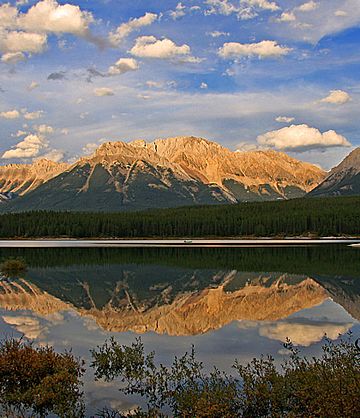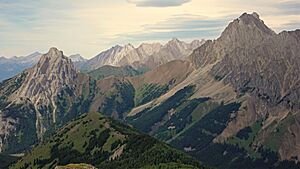Elpoca Mountain facts for kids
Quick facts for kids Elpoca Mountain |
|
|---|---|

Elpoca Mountain seen from Upper Kananaskis Lake
|
|
| Highest point | |
| Elevation | 3,036 m (9,961 ft) |
| Prominence | 460 m (1,510 ft) |
| Parent peak | Mount Evan-Thomas (3098 m) |
| Listing | Mountains of Alberta |
| Geography | |
| Location | Alberta, Canada |
| Parent range | Opal Range Canadian Rockies |
| Topo map | NTS 82J/11 |
| Geology | |
| Age of rock | Cambrian |
| Type of rock | Limestone |
| Climbing | |
| First ascent | 1960 by G. D. Elliot, H, Kirby, P.S. Scribens |
Elpoca Mountain is a tall mountain in the Canadian Rockies of Alberta, Canada. It stands at 3,036-metre (9,961-foot) high. You can find it at the southern end of the Opal Range.
The mountain is located inside Peter Lougheed Provincial Park. It is about 4.0 kilometres (2.5 miles) south of Mount Jerram. It is also 2.0 kilometres (1.2 miles) east of Gap Mountain. The closest higher mountain is Mount Evan-Thomas, which is about 12.0 kilometres (7.5 miles) to the north.
Mountain History
The name "Elpoca" is a special kind of word called a portmanteau. This means it's a word made by blending two other words together. "Elpoca" comes from the names of two nearby places: the Elbow River and Pocaterra Creek.
The name for Elpoca Mountain became official in 1928. This was decided by the Geographical Names Board of Canada.
The first time climbers reached the top of Elpoca Mountain was in 1960. The climbers were G. D. Elliot, H. Kirby, and P.S. Scribens.
How Elpoca Mountain Was Formed
Elpoca Mountain is made of sedimentary rock. This type of rock forms from layers of sand, mud, and tiny bits of plants and animals that settle over time. These layers were laid down a very long time ago, between the Precambrian and Jurassic periods.
Long ago, these rocks were formed in shallow seas. Later, during a big event called the Laramide orogeny, these rock layers were pushed up and over younger rocks. Elpoca Mountain was created during a specific part of this event called the Lewis Overthrust. The rock layers in the Opal Range are tilted steeply. Softer rock layers are found between harder ones.
Weather and Climate
Elpoca Mountain has a subarctic climate. This means it has very cold, snowy winters and mild summers. Temperatures can drop below −20 degrees Celsius (−4 degrees Fahrenheit). With the wind chill, it can feel even colder, sometimes below −30 degrees Celsius (−22 degrees Fahrenheit).
The best time to climb Elpoca Mountain is usually from June through September. During these months, the weather is more favorable for outdoor activities.
Water from the west side of the mountain flows into streams that lead to the Kananaskis River. Water from the east side flows into the Elbow River.
Images for kids





